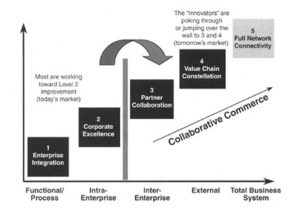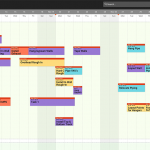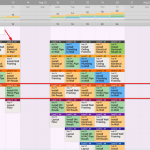In Post #2, we discussed an analog approach. The superintendent is doing a good job with planning and communicates the resulting demand signals to a supply chain manager [the project manager]. Now, we will focus on the interface between the supply chain and the jobsite.
In a phrase… It starts with Collaboration and Blossoms with Data.
Collaboration and Tech Integration
The first step is better collaboration across suppliers and contractors. When I brought up this idea in a round table discussion last week, an architect actually scoffed and said “good luck”. Refer back to post #3, where I emphasized the importance of partner collaboration. Step 4 in the chart below is next for Touchplan, and Step 5 is where we are headed.

What We Can Do Now: Expectation Management through Smarter Forecasting
Your project requires a particular piece of equipment, and the request looks feasible based on what the supplier is telling you is a reliable delivery date. What if your supplier is misinforming you because they aren’t actually forecasting?
The trade contractors doing most of the procurement typically act as go-betweens between the vendor and owner, and it puts them in a tight spot. Owners do not like being told their project schedules are slipping because of things outside of their control. However, a trade contractor could be able to do better expectation management by changing the conversation from “Well, they told me the lead for this vital piece of equipment is six months but they just told me it looks like it’s going to be another six months” to “The supplier gave me a lead time of six months, but looking at our own historical procurement data and a data set provided by the supplier, it’s likely to be more like 12 months,” and then provide a recommendation from there.
At present, you can use existing data to forecast with multiple regression or Monte Carlo. An integrated supply chain solution would automate projections of your supplier’s ship dates, continuously inform feasible production plans and adjust need-by dates and deliveries accordingly.
Systems That Talk to One Another
The next step is to automate the process through systems integration. Imagine if your project team didn’t have to do all of the planning in one place, then go to a procurement log somewhere and update need-by dates, and then make a phone call or send an email to communicate the data you just updated in the procurement log.
The ideal end state is one where supply chains respond to the production plan, and gives instant feedback about what is feasible.
That is the problem we are trying to solve by working with partners like Intelliwave, BitRip and PLOT. If you’re a contractor, supplier, owner, or tech platform, we are interested in working with you to move the industry towards integrated management of the supply chain and the jobsite. We’d love to talk. Reach out to [email protected] to hear more.










